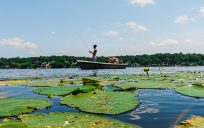The impacts of Hurricane Harvey are being felt far and wide. As the rain continued to fall, and flood waters rose, an army of citizen-rescuers answered the call, bringing their boats to bear and plunging into waist-deep waters to help those in their communities. While it’s not possible for all of us to lend a helping hand directly, those that know GIS can lend a hand from afar.
The need for expertise on the many “where” questions of a disaster continue to grow, answering such questions as
- Where are the one-story homes that are about to be immersed?
- Where are dry beds and shelters for those that are displaced?
- What are the quickest and safest routes to evacuate the most people in the shortest amount of time?
As the government encourages citizens to help one another, the non-profit organization made up of mapping experts is answering the call. GISCorps, a program of the Urban and Regional Information Systems Association (URISA), has been providing a range of mapping and disaster response services for more than 14 years worldwide.
GISCorps volunteers conduct most of their work remotely and nearly half of their work responding to disasters. These volunteers harness the power of the cloud-based ArcGIS Online platform for such tasks as data collection, data cleansing, and creating story maps and map galleries to communicate needs and impacts.
“GISCorps volunteers have been involved in almost every disaster since 2003,” says Shoreh Elhami, the founder of URISA’s GISCorps. “We have worked on Hurricane Katrina, the Asian tsunami, the cyclone in Burma, the Ebola epidemic, and many more.”
Volunteers gain the satisfaction of helping those in need, and there are many ancillary benefits.
“Many of our volunteers have said they learn more quickly from GISCorps experiences than from their day jobs,” said Elhami. “They get exposed to different projects that require different skills and tools, and that provides a valuable learning experience.”
GISCorps uses ArcGIS Online to spread the work among volunteers and to create a communication platform to share updates on unfolding events.
“Thanks to the backing from the Esri Disaster Response Program, we have a backend that supports the work of our volunteers,” said Elhami. “We can ingest and process imagery, and to digitize points of interest in a way that’s much easier than in the past. I’m really excited about putting our 5,000 volunteers to work doing a lot more.”
Applying to become a GISCorps volunteer can be done only online.





Leave a Reply
You must be logged in to post a comment.